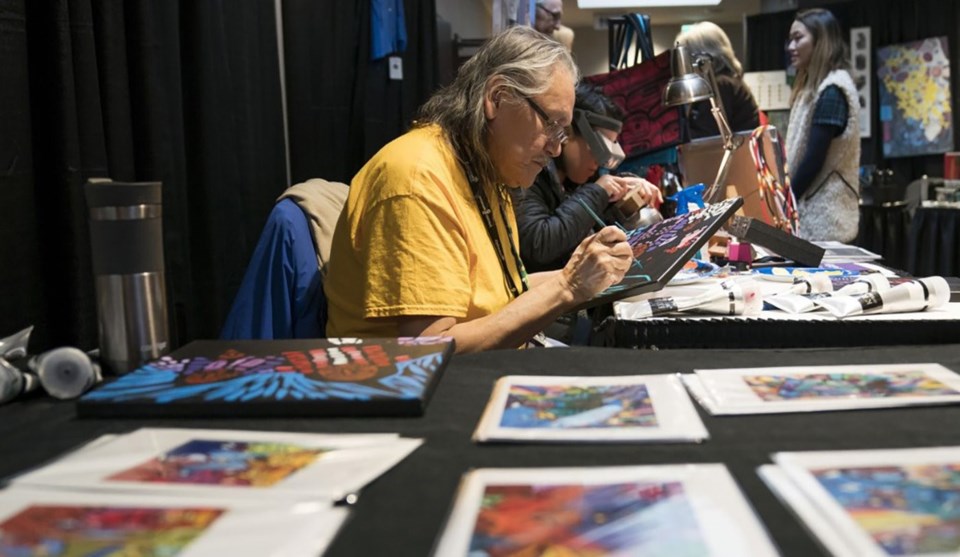Family is of great importance to Vancouver-based artist Jerry Whitehead. And when admiring the serene painting on the cover of the Alberta Native News June 2020 edition, the carefully chosen vibrant and rich colours painted on the previously blank canvas incorporates several nehiyawak (Cree people) representing Whitehead’s family. The painting is titled ‘Being Together.’
What is now present day Peter Chapman Band within James Smith Cree Nation in Saskatchewan, where Whitehead grew up, Jerry found various art implements that would open his mind up to the world of creativity and imagination. Whitehead explored different mediums to draw pictures by using lead bullets from his father’s hunting and trapping ammunition, ash as chalk from outdoor fires his grandparents would make, and before the invention of the plastic bag, Whitehead utilized brown paper grocery bags and catalogs as drawing paper.
The iskwew (Cree woman) that is a central figure in Whitehead’s paintings represents the strong influence in his life that he has carried with him in his heart and throughout his lifetime. nihtâmâmawâyâwin (Being Together) was created when Whitehead reflected on the relationship he shared and cherished with okawiya (his mother). Throughout Whitehead’s art journey, he has painted his mother as the central figure in his artwork. The iskwewin the middle of the painting nihtâmâmawâyâwin, is okawiya surrounded by her husband, parents, children, grandchildren and children with no faces representing future children, the next generations to come.
Being Together by Jerry Whitehead. (Supplied by the artist)
For over 40 years as a professional artist, Jerry Whitehead has been capturing people’s awe and attention with every brush stroke featuring vibrant hues of purples, blues, greens, yellows, reds, oranges and pinks that he methodically paints onto all of his art pieces. As a young child, Whitehead was drawn to bright vibrant colors. His mother influenced his attraction towards the vibrant rich colors that we see today in all of his artwork. A memory that Whitehead treasures from when he was a napesis (boy), was when he would watch okawiyacut up colorful rags, and then braid them together to make rugs. He would play on the floor in his family home with all the different colors of fabric. Because Whitehead's first memory of colour is tied to okawiya, she was also his first teacher that taught him about color.
nihtâmâmawâyâwin is a compilation of Whitehead’s many painting styles. He incorporates the majestic Northern Lights of our ancestors dancing into the background. The stained glass painted dancers on the bottom right reflect the many colours that our people wear on their regalia when dancing in isihcikewin (ceremony). On the bottom left of Whitehead’s creation, the mosaic patterns shaping the powwow dancers’ faces is another style of painting that is distinctly recognizable as a Whitehead art piece.
"Powwow dancers have been an ongoing theme in my work since I began painting. Seeing the dancers as a child had a lasting impression. The subject matter has been ideal for expressing a part of my culture as well as accommodating changes in my work."
In each one of Whitehead’s creations, powwow dancers have been an ongoing theme. The women and men on every canvas, rock, wall, and media of choice are identified by their regalia and the number of feathers painted above their heads. iskwew have a single feather and the men are painted with two feathers that correspond with the dancer’s regalia. The iskwew also have shawls and the men have medallions. isihcikewinis incorporated into every one of Whitehead’s brush strokes, and when speaking with him, his love and gratitude towards Indigenous culture exudes genuine warm-heartedness into every conversation.
Jerry Whitehead grew up in a family with 10 children. And while growing up, Whitehead was always surrounded by his family. The island painted in the middle of the painting nihtâmâmawâyâwin, represents peace and quiet, a safe place when being with family; Whitehead thinks of it as his own little island of family. And within the island there is a story, one that reminds Whitehead of tranquility, part of healing and part of his gift that he shares with the world.
Whitehead’s passion for art has taken him on a journey throughout Canada and has touched many hearts. Some of his recent artwork throughout amiskwaciwâskahikan (Edmonton) can be found on campus at the University of Alberta and the Indigenous Art Park. Whitehead also has a website showcasing his various styles of painting, starting with his art journey using oil-based paints and then eventually switching over to acrylic paints.
Whitehead has a Bachelor of Arts degree (in Indian Art) from the First Nations University of Canada and a Bachelor of Fine Arts degree from the Nova Scotia College of Art and Design in Halifax. He encourages people to find their creativity and use it as a form of healing. When spending time with little ones, like his granddaughter that paints with him, he emphasizes that “every child is an artist. They are [gifted] in certain ways. And if you keep encouraging kids, they will become artists,” and the next generation can carry on telling stories through various forms of art.




